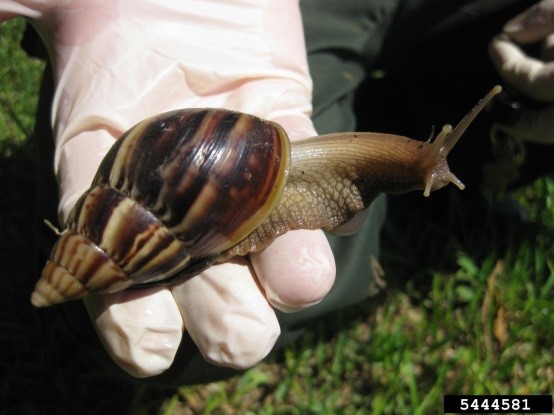
INVASIVE WATCHLIST | GIANT AFRICAN LAND SNAIL
With invasive threats on the rise, it’s been essential for Michigan to continue to protect not only our natural resources, but to also take into consideration our economy, and the effects nonnative species can have on it. The food and agriculture industry contributes $101.2 billion annually to the state’s economy, and accounts for nearly 22% of the state’s employment. As the state’s Invasive Species Watchlist continues to gain new species it’s important to stay up to date. For instance, the Giant African Land Snail could pose serious threats to the state’s agriculture industry. Read on to find out more!

The Giant African Land Snail, is believed to have been native to East Africa, and has established itself throughout the Indo-Pacific Basin, including the Hawaiian Islands, as well as the Caribbean islands of Martinique and Guadeloupe, and multiple species becoming agricultural pests in the U.S. as well.
The “Giant African Land Snail” is the common name used to describe any of the three snail species native to Africa, including: the giant Ghana tiger snail, margies, and of course the giant African land snail. The best method for identifying snails is by their size. These large, terrestrial snails can reach up to 8 inches in length and about 4 inches in diameter. If the shell is more than two inches long, it’s more than likely a giant African land snail. The shells are also brownish, and typically the size of an adult sized fist, and sometimes have darker brown vertical stripes that covers at least half of the length of the snail. If you’re unsure of the snail breed, it’s best to err on the side of caution and call to have the snail collected.
These snails have been removed from pet stores, schools, and private residents are urged to voluntarily turn in any giant African land snails they may have, without fear of penalty. If you do possess a giant African land snail, it’s really important to have them collected by a state or federal inspector, rather than disposing of them back into the environment, as well as any eggs or bedding that may have been in contact with the snail.
These snails are illegal in Michigan and the continental U.S. because of their highly invasive tendencies, and due to the extensive damage they can cause to important food crops and other agricultural and natural resources, as well as the risk they pose to human health. These snails have huge appetites, and are known to eat over 500 different plants. When fruits and vegetables are unavailable the snails will consume ornamental plants, tree bark, and even paint from houses. Not to mention their high volume reproduction rates. They can lay as many as 100 to 400 eggs in a single session, and they contain both female and male organs making reproduction even easier. In a year they can produce up to 1,200 eggs. Another reason for not disposing of them into the wild, they can survive the snow, and hibernate until the weather warms again.
The reason for turning the snails into a state or federal inspector isn’t to get you into trouble; it’s actually a great way to trace the origin of the snails, which helps reduce the risk of more snails finding their way into classrooms, pet stores, or private homes. So keep your eyes open for this slimy little pest!
This article is part of the ongoing series on invasive species funded in part with funds from the Michigan Invasive Species Grant Program through the Departments of Natural Resources, Environmental Quality, and Agriculture and Rural Development

A lake in Glennie has these…